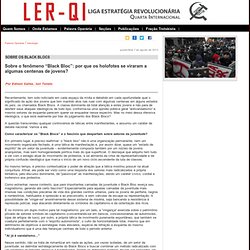

Networked revolution. There is a strong tendency, almost a rule, that anarchist groups tend to fall apart once they have more than 20-30 members in any city or 50 to 60 overall.

Or at the very least an organisation that once felt like it worked very well becomes one that feels sluggish and starts requiring too much effort to achieve limited results in the longer term. There are exceptions which mean this is not inevitable but why does this happen and more importantly how can we avoid it in our organising? The cause may be simply a limitation of our brains and in particular the number of complex inter relationships between people we can track. Or, more correctly, a failure to acknowledge that this limit means that informality will fail and formal administration is more and more necessary as group size rises.
A lesson that is not just relevent to anarchist but to all attempts at horizontal organisation. A.2 What does anarchism stand for? Printer-friendly version These words by Percy Bysshe Shelley gives an idea of what anarchism stands for in practice and what ideals drive it: The man Of virtuous soul commands not, nor obeys: Power, like a desolating pestilence, Pollutes whate'er it touches, and obedience, Bane of all genius, virtue, freedom, truth, Makes slaves of men, and, of the human frame, A mechanised automaton.

As Shelley's lines suggest, anarchists place a high priority on liberty, desiring it both for themselves and others. They also consider individuality -- that which makes one a unique person -- to be a most important aspect of humanity. They recognise, however, that individuality does not exist in a vacuum but is a social phenomenon. In order for individuality to develop to the fullest possible extent, anarchists consider it essential to create a society based on three principles: liberty, equality and solidarity.
Tactics. Understand the Israeli - Palestinian Apartheid In 11 Images » ThrivalRoom. YouTube. Dessine-moi l'éco : Qu'est-ce qu'un paradis fiscal ? Unissons-nous contre l'austérité. Errico Malatesta - Teoria e Estratégia Anarquista. Review: The Failure of Nonviolence: from the Arab Spring to Occupy.
By Peter Gelderloos, Left Bank Books, Seattle 2013 Protesters in Barcelona learn that pacifism is not a very practical way to resist.

Review by Zig Zag, Warrior Publications, August 11, 2013 The basic premise of this book is that advocates of pacifism have lost the debate over tactics and strategies used by social movements, and only those that have used a diversity of tactics have been successful. A promising premise and even more promising title, considering the recent manifestations of revolt and protest that characterized the Arab Spring and Occupy movements, and the “official” pacifist narrative that portrays these as victorious examples of nonviolence.
Since these two movements are both recent and have served as inspiring examples for a new generation (including, it could be argued, the Idle No More wave of protests), the task of unraveling the false narratives pushed by pacifists seems both timely and highly relevant. It’s an odd list, to be sure. Like this: Like Loading... Sobre o fenômeno “Black Bloc”: por que os holofotes se viraram a algumas centenas de jovens? Recentemente, tem sido noticiado em cada espaço da mídia e debatido em cada oportunidade qual o significado da ação dos jovens que tem mantido atos nas ruas com algumas centenas em alguns estados do país, os chamados Black Blocs.

A classe dominante dá total atenção a estes jovens e não para de desferir seus ataques ideológicos de todo tipo; conforma-se uma opinião pública geral “antivandalismo” e mesmo setores da esquerda parecem querer se enquadrar nesse espectro. Mas no meio dessa ofensiva ideológica, o que está realmente por trás do julgamento dos Black Blocs? A questão transcendeu qualquer controvérsia de táticas entre manifestantes, e assumiu um caráter de debate nacional.
Vamos a ele. Como caracterizar os “Black Blocs” e o fascínio que despertam sobre setores da juventude? Ao mesmo tempo, é preciso contextualizar o poder de atração que a tática mostrou possuir na atual conjuntura. “Aí já é vandalismo...” Nem ‘vítimas’, nem ‘vândalos’ PS: A aritmética revolucionária de Valério Arcary. Direct action « The 2012 Quebec student strike. At this point, it’s important to clarify the concept of direct action in the context of the strike.

In essence, direct action is about students themselves being the main actors of their struggle, as opposed to representatives. As such, it’s the counterpart to the direct democracy of student unions. Direct action is also about refusing mediation of the conflict by groups or individuals who often empower themselves at the expense of those on whose behalf they claim to speak, forcing them, explicitly or not, into roles of mere spectators. The “acceptable” political channels such as mass media and closed-door dialogue under the guise of “solution-building” are always primarily aimed at the pacification of conflicts and are thus incompatible with direct action. The aim is to build the struggle outside, and often in opposition to, the official political process. Of course, an important consequence of encouraging direct action is the repression that often follows. » Expansion.